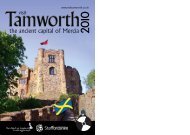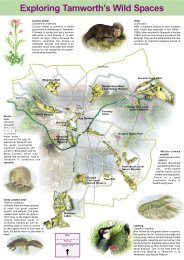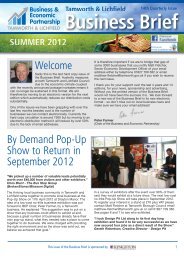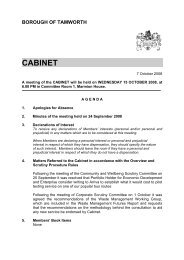Conservation Management Plan - Tamworth Borough Council
Conservation Management Plan - Tamworth Borough Council
Conservation Management Plan - Tamworth Borough Council
You also want an ePaper? Increase the reach of your titles
YUMPU automatically turns print PDFs into web optimized ePapers that Google loves.
Royal Visits<br />
We know that the enhancements to the accommodation were successful as King James I visited on three occasions<br />
in 1619, 1621 and again in 1624. There are apotropaic (evil-averting) marks on the entrance porch to the south range<br />
to ward off witches and they may well belong to the time when James I was visiting. These marks are usually sited<br />
around any apertures such as doors and windows where witches might slip into a building. James had taken a<br />
particular interest in witches and witchcraft and considered himself somewhat an expert on the subject. In Scotland<br />
in 1590 300 witches were accused of gathering to plot the murder of James. He is known to have had a morbid fear<br />
of violent death. In 1604 he passed the Witchcraft Act.<br />
The Castle during the Civil War<br />
The Castle was occupied by Royalists in autumn 1642. On 23 June 1643 parliamentary troops laid siege upon the<br />
castle and the royalists surrendered after 2 days. In the following March Royalists troops from Lichfield assembled<br />
a force to try and retake <strong>Tamworth</strong>, but the attempt failed. In October the parliamentary garrison was ordered to<br />
leave. Cromwell later ordered that many castles should be dismantled, but there is no tangible evidence that this<br />
was ever carried out at <strong>Tamworth</strong>.<br />
Sir John Ferrers V Probate inventory<br />
The probate inventory of John Ferrers, made in 1680 is the most important document referring to the post medieval<br />
castle, providing remarkable insight into room functions and contents at this date, as well as the overall planning<br />
and organisation of the buildings. It is a valuable for the furnishings and decor of the domestic interiors around the<br />
time of the restoration of Charles II.<br />
Although the inventory was listing only moveable goods, it also names many of the rooms, and the route around<br />
the accommodation, so it is possible to assign descriptions and functions to specific rooms.<br />
However, there has been considerable change to the north range, since John Ferrers’ time: the attics in the north<br />
range were taken down by the Townsends and at least one partition wall has been removed, the service rooms on<br />
the west side of the open hall have been replaced and a partition wall has been removed from the top floor of the<br />
storeyed entrance porch.<br />
In the south range the top floor has been dismantled, so there is a degree of speculation about the contents of<br />
some of the seventeenth century rooms. It is likely that some of the service buildings were sited in the bailey, and<br />
the brief notes of the excavations by Wainwright in 1960 did refer to ‘Tudor’ buildings within the bailey.<br />
North Range<br />
We can identify ‘My ladyes chamber’ on the top floor of the tower, with an adjacent nursery on the floor below in<br />
what is now described as the ‘Ferrers Room’ above the storeyed entrance porch.<br />
The former dining room with fine bay and oriel windows looking out over the town on the north side of the castle,<br />
was described as the ‘Guilt Leather’ room. The current municipal cream painted walls give no indication of how<br />
warm and sumptuous this room must have been, with its walls lined with stamped and gilded leather. There are<br />
numerous National Trust and other properties where this ‘gilt leather’ or ‘Cordovan leather’ survives and these are<br />
illustrated and discussed in the room data sheets within the gazetteer.<br />
Clearly at this time this room and its associated service rooms and annexes would have provided the main<br />
accommodation suite for significant visitors such as King James.<br />
<strong>Tamworth</strong> Castle <strong>Conservation</strong> <strong>Management</strong> <strong>Plan</strong> www.marionblockley.co.uk<br />
Part 1<br />
33







